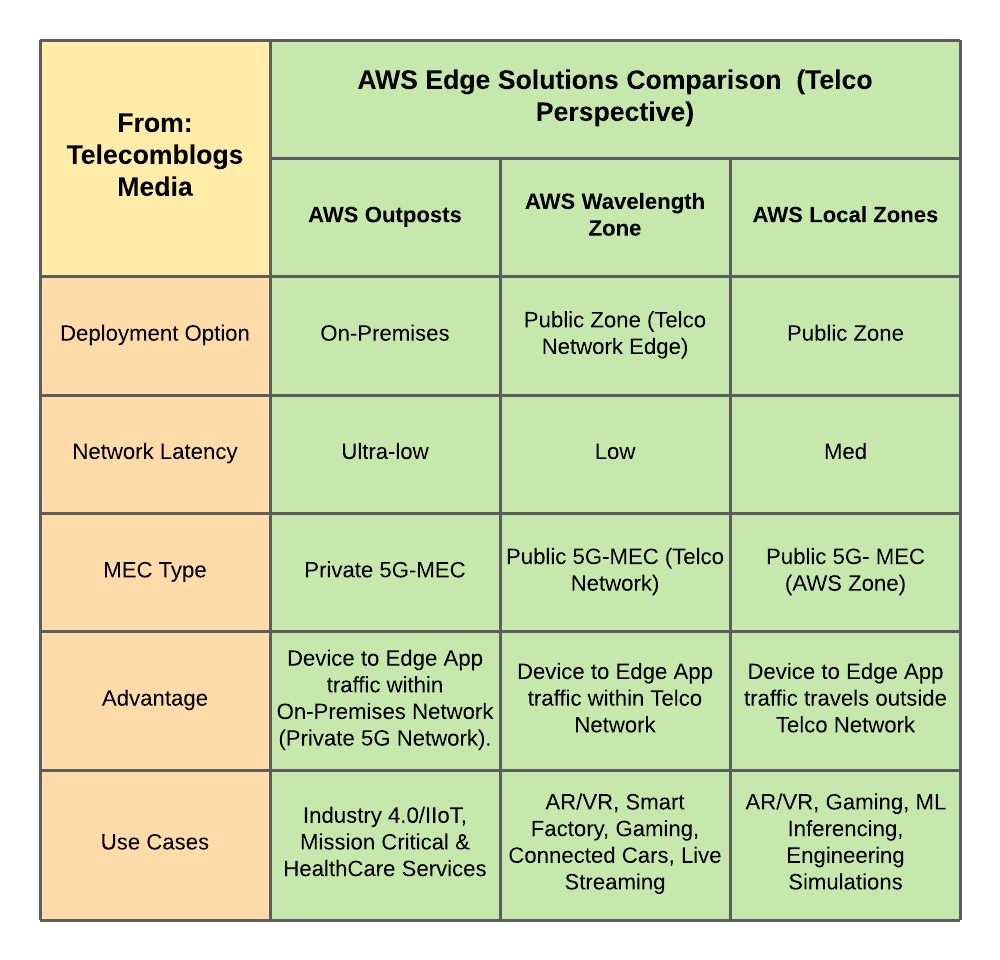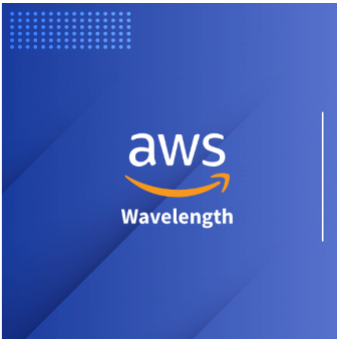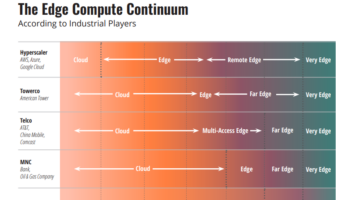(The blog post is series of blogs, which talks about various Public Cloud Providers Edge/MEC Offerings from use case perspective. In this blog, we will explore AWS Wavelength based Smart Factory Solution.)
As edge computing race is heating up, AWS, the biggest cloud provider on the planet, has rolled out couple of solutions to meet the requirements of edge use cases. According to AWS, it categorized its edge offerings into, three distinct infrastructure setups (from Telco perspective), namely (there are many other offerings, but for sake of this post, we will only focus on specific offerings):
- AWS Wavelength (or Wavelength Zone): These are AWS Infrastructure Zones, built for a specific Telco and infrastructure is part of Telco’s 4G/5G Network. Currently AWS offers these zones for Verizon in US, KDDI in Japan, SK Telecom in South Korea, and Vodafone in UK. From Telco perspective, it will be a Public MEC deployment at Telco Network Edge.
- AWS Outposts: This offering is more of deploying entire AWS Infra stack right on-premises of the specific customer, a private network deployment. From Telco perspective, it will be a Private MEC deployment.
- AWS Local Zones: This is an interesting offering from AWS, something quite like Wavelength Zones but built outside telco’s network (or not specific to Telco), within AWS Infra region. Any telco/MVNO or Enterprise can leverage these low latency local zones for different edge use cases. From Telco perspective, it will be a Public MEC deployment, outside Telco Network Edge, as traffic from device app could travel outside Telco network before it reaches backend edge/MEC app.
AWS talks at length on its product pages about choosing right offering for specific use cases, locations, and other details at great length which we won’t discuss here. The purpose of this post to discuss a specific use case at length deployed with AWS Wavelength.
Currently, from US perspective, Verizon is using Wavelength Zones for MEC/Edge Use cases while another greenfield operator Dish Wireless announced that they will be using AWS Outposts and Local Zones for Edge/MEC deployments.
Choosing the right offering from a telco perspective could be a great dilemma, although AWS does talk about it briefly in FAQ section, of all offerings, highlighting the differences, but it doesn’t make distinction very clearly in terms of end-to-end network latency with all three. Although from re-presentation perspective, shown below, it’s safer to assume that AWS Outposts, being on-premises, offers the best network latencies while Local Zones offer much higher latencies among three. The actual latencies could vary and needs further investigation.
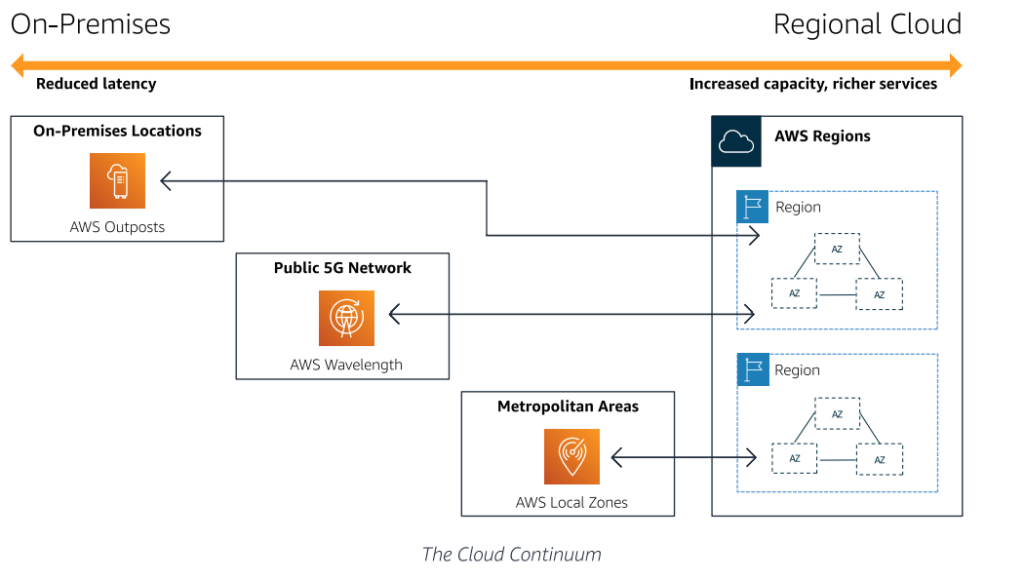
Smart Factory with AWS Wavelength
For a Smart Factory Use Case, the factory setup shown below, and has distinct set of sensors, cameras, and vision systems, supplied by different vendors. Among numerous challenges currently faced by the factory, some of them include, multi-vendor system integration, high latency (cloud-based system for processing sensor data), security, and scalability (plant expansion, cabling etc. issue).
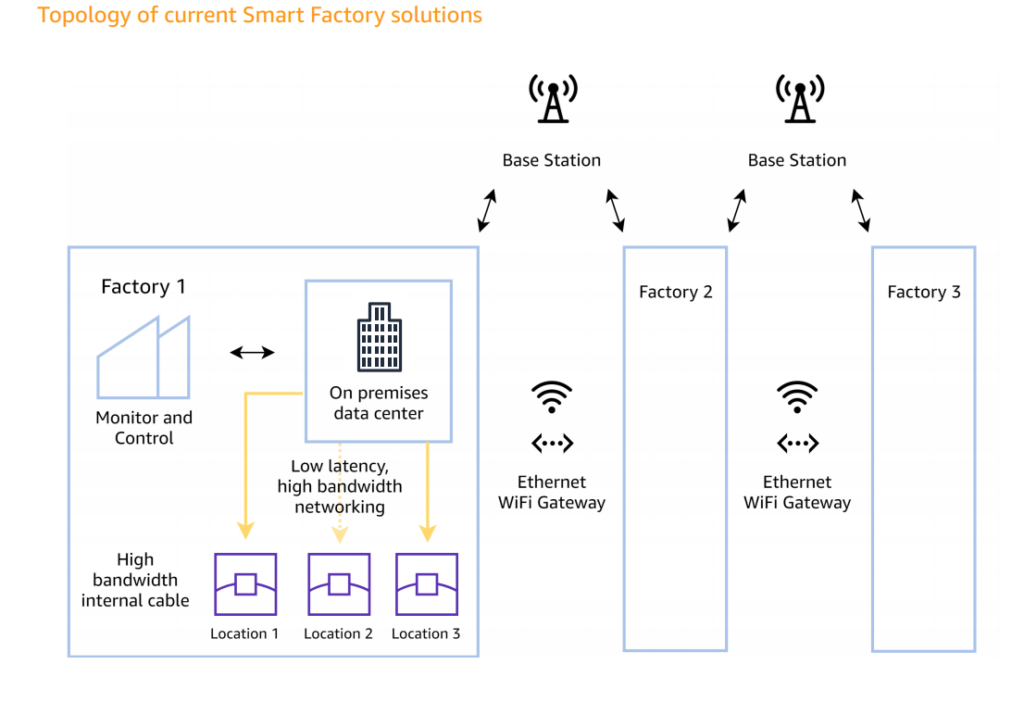
AWS has chosen Wavelength Zone (mostly with a Telco) to deliver low latency and higher throughput (Video streams) to deliver remote inspection use case for the factory.
In the setup, cameras from factory plants stream live video streams to AWS Wavelength Zone infrastructure over 5G. At the zone, there’s AWS Infra, running Video Analytics Inferencing pipeline, detects defects in production line, notifies the plant operator, over 5G, in real-time. Video streams are also sent to cloud storage (S3).

AWS highlights that, choosing Wavelength Zone is right approach here, compared to Outposts based solution (on-premises Edge), for economic reasons. Moreover, in this setup, factory doesn’t have to operate or maintain the infra, which resides at a Wavelength Zone, or telco operator’s network edge.
The setup above is an example of Public MEC deployment by a telco, for a factory, with the help of cloud service provider (AWS), also involving an ISV (TCS) who built the MEC App or Video Analytics solution. The partnership model, demonstrated by AWS, is in-line with our thought process outlined in my previous post. Although it’s not clear what’s network latency achieved compared to cloud setup, but we assume it meets criteria of delivering use case at network edge. Moreover, as economic reasons weigh more important here, had AWS chosen Outposts (Private MEC) based deployments, we believe the latency and throughput could have been better than Public MEC setup.
On the 5G side, as this is Public MEC setup, the video streams from factory campus (RTSP) streamed to Wavelength Zone over 5G. There’s no clarity if Wavelength Zone is co-located with 5G gNB but it’s safe to assume, there’s no delay in transfer of video streams from gNB to Wavelength Zone. Another aspect which isn’t clearly mentioned about 5GC, and we assume, 5GC resides within telco’s central DC and not deployed at Wavelength Zone itself (unlike Private MEC setup). This needs to be verified as it could add additional delay, esp. from control path setup but less on data path. Moreover, it’s also not clear, if AWS Wavelength Zone to AWS Cloud connectivity is using 5G or AWS Direct Connect to transfer video streams to S3 buckets.
Summary
AWS offers different solutions for deployment of Edge/MEC Applications, namely Outposts, Wavelength Zone and Local Zone for Telcos. Wavelength Zone based solution offers many advantages, esp. it brings AWS Compute, Storage, and network resources closer to customer (Devices), compared to cloud setup, improving end-to-end latencies, important from edge/MEC perspective, improving overall user experience. Moreover, Wavelength Zone is part of Telco Network setup, so app traffic doesn’t travel outside telco network making it more secure architecture. It also doesn’t require end customer to deploy its own cloud infra/edge setup on-premises, and leverages telco setup, offering better turnaround time. In the end, Wavelength Zone is part of AWS Region architecture, offering required resiliency for edge data center setup, which often runs mission critical services.
On the downside, we clearly see, this particular use case could be better off on AWS Outposts, which would offer lesser latencies compared to Wavelength Zone. It would require factory to setup its own Private 5G Network or Hybrid setup could also be possible. Moreover, outposts also offer better security and data governance as data entirely resides within on-premises, reducing network bandwidth usages as well.
Overall actual latency varies from each type of deployment, outposts offering the ultra-low, while local zones offer medium latencies. Depending on the use case and required latency, telcos need to select appropriate deployment option, as no option is better than other, in consultation with end customer’s requirement. There are other deciding factors, including time to market, CAPEX, data privacy & security, and complexity of setup, to look at before choosing the solution.
In summary, AWS has demonstrated the successful 5G-MEC partnership model to deliver, Smart Factory Use Case, with Wavelength Zone Public MEC Setup over 5G.
